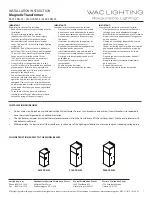
Preliminary Technical
Data
Rev. PrA | Page 37 of 82
•
Interference/high noise levels in Tx-ORx channels can cause the EVM and error percentages to increase. Fault conditions and
corresponding recovery actions can be defined for EVM numbers to avoid bad DPD updates.
•
As Tx signal level decreases, the EVM percentages increase. However, an argument can be made that DPD might not be
required at lower signal levels for certain PAs.
•
Another factor to note is the DPD model that the user configures the part with. An incompatible prior DPD model configured
by the user can cause the EVM and error percentages to increase leading to poor DPD performance.
•
Catastrophic conditions such as loss of signals can also lead to high EVM and error percentages which can be monitored by
the user.
Shown above are some of the scenarios that could cause degradation of DPD performance. However, it is advised that the user
characterize the system under test for EVM corruption that is specific to the system or conditions prevalent before configuring
the thresholds.
DPD CHARACTERIZATION FOR OPTIMIZING M-THRESHOLD
A DPD characterization test for optimizing M-Table threshold in DPD Mode 2 includes the following steps:
1.
Bring up DPD with a full power, full bandwidth signal (for example, TM3.1a at -14 dBFS and 100 MHz BW)
2.
Once DPD converges, turn off DPD.
3.
Sweep power in 1 dB steps from full power to ~15 dB backed off level.
4.
Record ACPR, ACP and EVM of demodulated data at each level. An example tabulation of characterization data is shown in
Figure 41. DPD Characterization for Optimizing M-Threshold in DPD Mode 2
For the example shown above, the characterization data relative to a 45 dBc ACP specification and 2.5% EVM is plotted in Figure
42. The figure shows that, although DPD performance is sustained across power levels, the EVM violates the 2.5% specification at
approximately –24 dBFS. Based on the characterization data, it can be determined that that optimum M-Table threshold in DPD
mode 2 is –24 dBFS.
















































